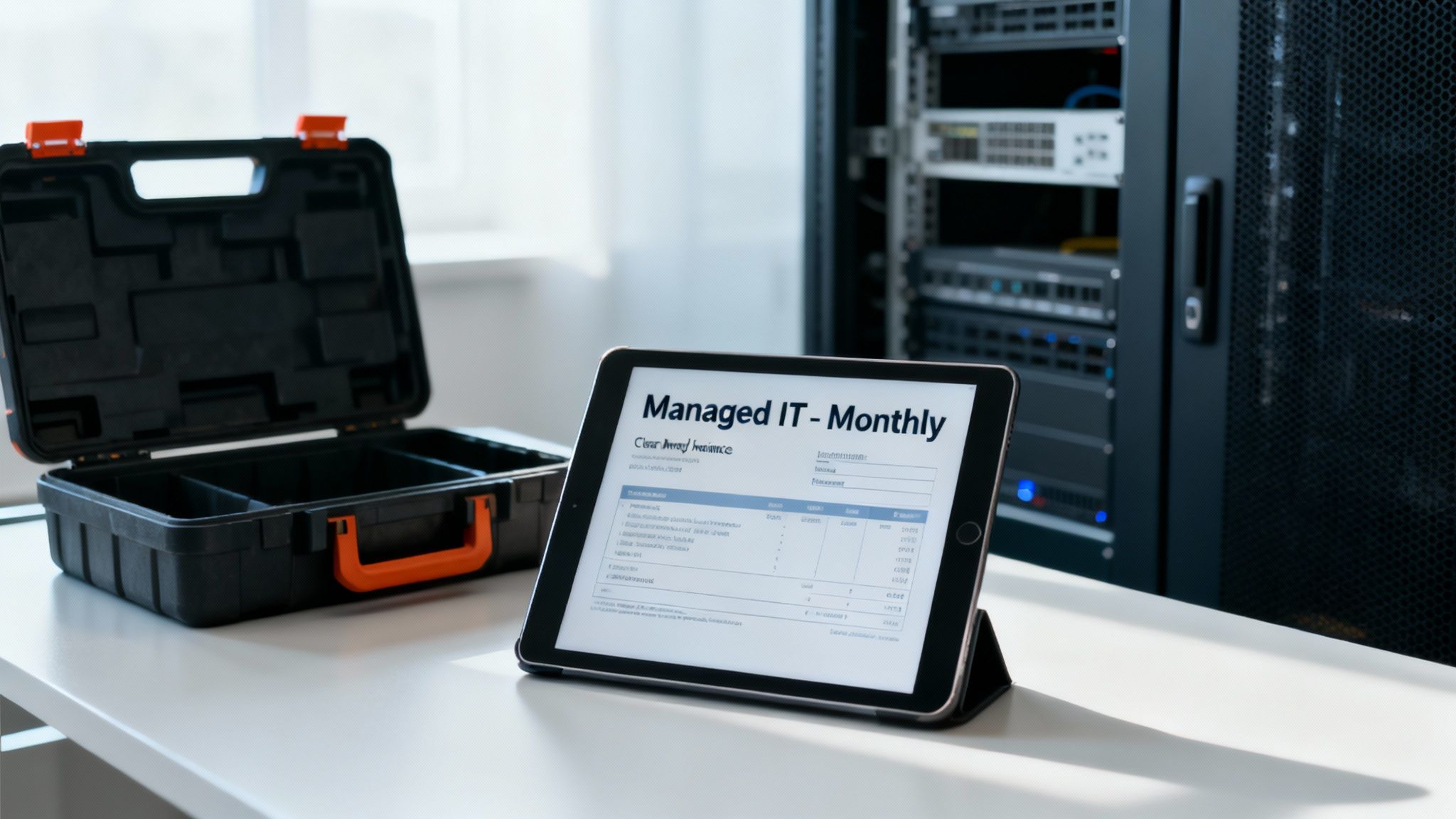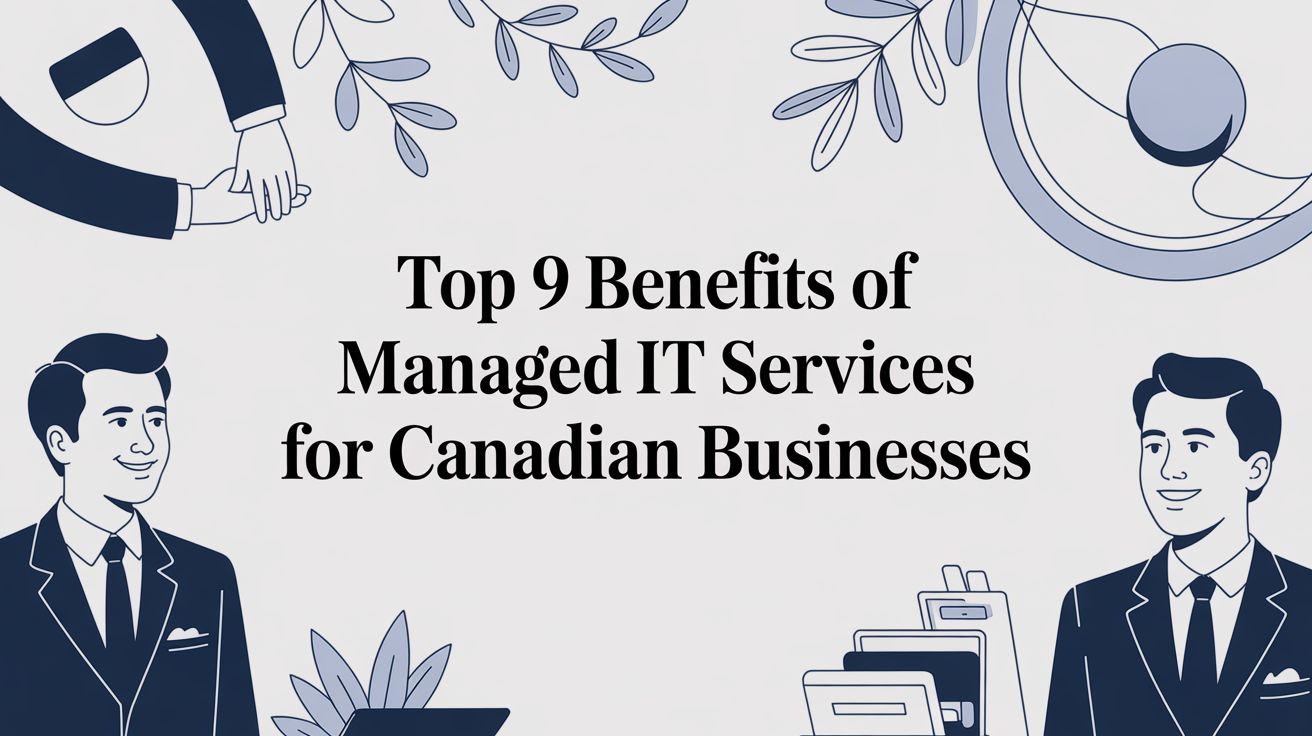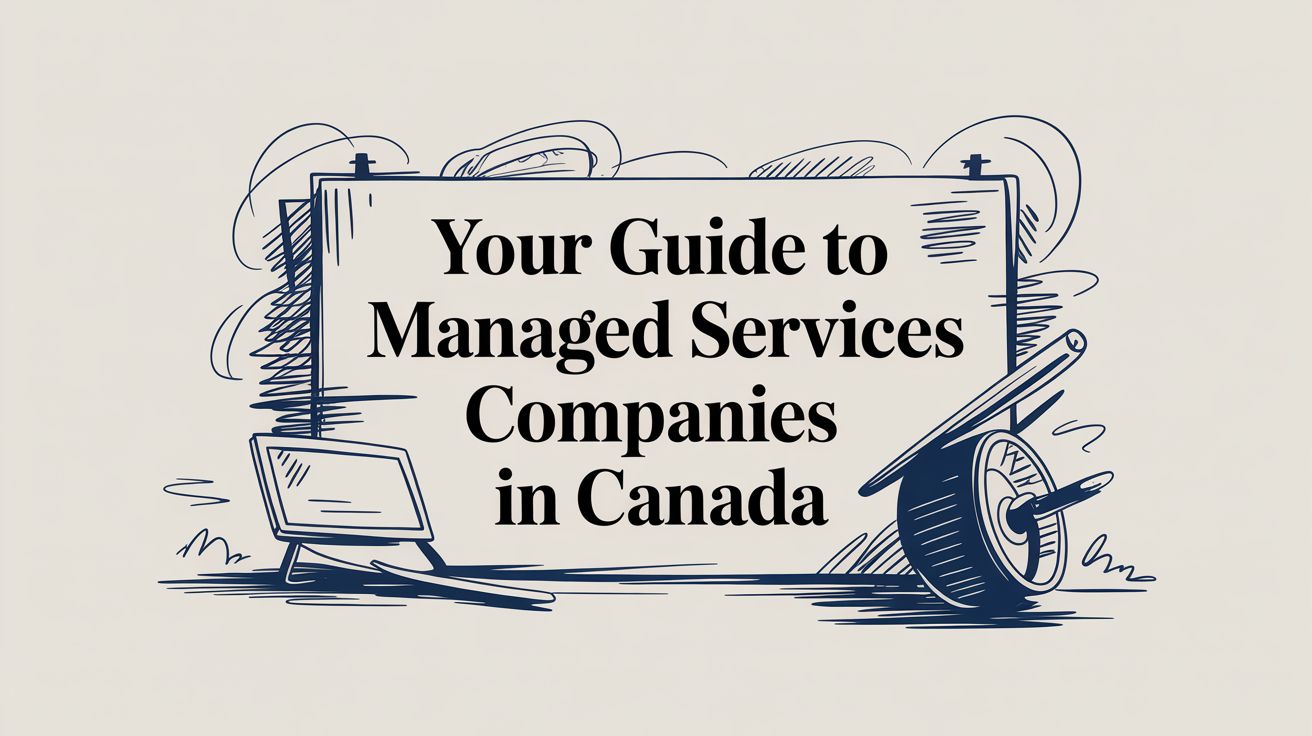In today's competitive market, Canadian businesses are under constant pressure to innovate, scale, and protect themselves against ever-evolving cyber threats. For many medium-sized organizations, managing an in-house IT department can be a costly distraction, pulling valuable resources away from core business objectives. The reality is that outdated systems, reactive problem-solving, and a lack of specialized expertise create significant operational bottlenecks and security vulnerabilities. These challenges are not just inconvenient; they can directly impact your bottom line and stunt your growth potential.
What if you could transform your technology from a resource drain into a strategic asset? This is where understanding the benefits of managed IT services becomes crucial. This modern, proactive approach provides the enterprise-grade expertise and robust infrastructure needed to drive efficiency, secure sensitive data, and accelerate growth, all for a predictable monthly cost. When you properly vet a partner, such as by learning about the specifics of Choosing a Managed Service Provider (MSP) for AWS, you gain a clear view of how they can optimize critical parts of your infrastructure.
This guide moves beyond generic advice to deliver actionable insights. We will break down the nine most impactful benefits of outsourcing your IT, from reducing operational costs and enhancing cybersecurity to improving business continuity. Each point is explained with practical examples and industry-specific implications for sectors like healthcare, manufacturing, and law, showing you precisely how a managed services partnership can give your organization a decisive competitive edge. You will learn how to turn your technology management from a reactive burden into a proactive driver of business success.
1. Drastically Reduce and Predict Your IT Operational Costs
One of the most immediate and impactful benefits of managed IT services is the ability to transform your technology budget from a volatile, unpredictable capital expense (CapEx) into a stable, fixed operational expense (OpEx). Instead of reacting to costly emergencies like hardware failures or urgent software upgrades, your organization pays a predictable monthly fee. This strategic shift eliminates the substantial overhead tied to hiring, training, and retaining a full in-house IT department.

This model allows for precise budgeting and significantly improves cash flow management. By outsourcing, you gain access to enterprise-grade tools, expertise, and 24/7 support without the associated enterprise-level price tag.
How It Works in Practice
Financial predictability empowers you to reallocate capital towards core business functions that drive growth, like product development or market expansion.
- Manufacturing: A medium-sized Ontario manufacturing firm can slash its annual IT spend by up to 40% by offloading server maintenance and in-house staff overhead to an MSP.
- Legal: A growing legal practice in Alberta can avoid the six-figure upfront cost of building an internal IT department by adopting a managed services model from its inception.
- Healthcare: A British Columbia clinic can reduce infrastructure costs while ensuring its IT systems remain fully compliant with provincial privacy laws (PIPA) through a specialized MSP.
Key Insight: Converting IT costs to a fixed OpEx model isn't just about saving money; it's about gaining the financial stability to invest confidently in your business's future. With a predictable IT budget, you can plan long-term growth strategies without the fear of sudden, high-cost technology crises derailing your plans.
Actionable Tips for Implementation
To maximize cost savings and predictability, follow a structured approach when evaluating managed IT services.
- Conduct a Cost-Benefit Analysis: Tally your current IT expenses, including staff salaries, benefits, hardware lifecycle costs, software licences, and the estimated cost of downtime. Compare this total to quotes from several Canadian-based MSPs like CloudOrbis.
- Secure a Clear Service Level Agreement (SLA): Negotiate a fixed-rate contract with a clearly defined SLA. This document should detail service response times, uptime guarantees, and the full scope of included services to prevent unexpected charges.
- Demand Transparent Billing: Request detailed billing breakdowns to understand exactly where your investment is going. This transparency helps identify where you are achieving the most significant savings and ensures you're only paying for the services you need.
2. 24/7 Monitoring and Support
One of the core benefits of managed IT services is gaining a team that never sleeps. Managed Service Providers (MSPs) offer round-the-clock monitoring and technical support, ensuring your systems are continuously watched for issues before they escalate into critical, business-halting problems. This proactive approach means potential threats are detected and resolved outside of typical business hours, minimizing disruption and ensuring business continuity.

This constant vigilance is a strategic advantage, moving your IT posture from reactive to proactive. Issues like network slowdowns, security breaches, or server failures can be identified and often automatically remediated by the MSP’s advanced tools, long before your team even notices a problem. Learn more about the tools that make this possible through remote monitoring and management.
How It Works in Practice
Proactive, 24/7 support drastically reduces costly downtime and protects revenue streams by ensuring your critical systems are always operational and secure.
- E-commerce: A national retail brand based in Toronto can prevent thousands in lost revenue by having its e-commerce platform monitored overnight, ensuring any server issues are fixed before the morning sales rush.
- Manufacturing: A 24/7 manufacturing plant in Alberta can detect IT failures in its production line equipment before they cause a complete stoppage, saving hours of downtime and production losses.
- Financial Services: A Calgary-based investment firm meets strict regulatory uptime requirements and protects sensitive client data by leveraging continuous security monitoring from a dedicated MSP.
Key Insight: 24/7 monitoring isn't just about fixing problems faster; it's about preventing them from ever impacting your operations. This constant oversight ensures maximum uptime, enhances security, and provides peace of mind, allowing you to focus on your core business objectives without worrying about your technology infrastructure.
Actionable Tips for Implementation
To get the most out of round-the-clock support, you must establish clear expectations and procedures with your provider from the outset.
- Define Incident Response Times in an SLA: Your Service Level Agreement (SLA) should clearly outline response times for different incident severity levels. A critical server outage should have a much faster response guarantee than a minor software glitch.
- Establish Clear Communication Channels: Determine your preferred methods for alerts and support requests, whether through a dedicated portal like CloudOrbis’s IT Button, email, or a direct phone line.
- Schedule Regular Alert Reviews: Meet with your MSP quarterly to review monitoring logs and alert histories. This helps identify recurring issues and allows for strategic adjustments to prevent future problems.
3. Enhanced Cybersecurity and Compliance
In today's high-stakes digital landscape, maintaining robust cybersecurity and adhering to complex regulatory standards is non-negotiable. One of the most critical benefits of managed IT services is gaining access to enterprise-grade security architecture that protects your business from evolving threats while ensuring you meet stringent industry-specific compliance mandates. An MSP acts as your dedicated security partner, implementing a multi-layered defence strategy that most in-house teams lack the resources or specialized expertise to manage alone.

This proactive approach shifts your posture from reactive damage control to proactive threat prevention. By leveraging advanced tools for threat detection, vulnerability management, and 24/7 monitoring, an MSP fortifies your digital assets against ransomware, data breaches, and other cyberattacks. For a deeper understanding of these protective measures, a comprehensive cybersecurity guide for MSPs can illustrate the advanced strategies involved.
How It Works in Practice
Partnering with an MSP gives you a specialized security operations team that manages everything from endpoint protection to ensuring your data handling practices meet legal requirements.
- Healthcare: A Toronto-based clinic can ensure its patient data management systems are fully compliant with Ontario's PHIPA regulations, avoiding severe penalties for data breaches.
- Retail: An e-commerce business in Alberta can maintain PCI-DSS compliance for its payment processing systems, protecting customer financial data and securing its reputation.
- Legal: A law firm can secure sensitive client information with advanced encryption and access controls, upholding its duty of confidentiality and preventing unauthorized access.
Key Insight: Cybersecurity and compliance are not one-time projects; they are ongoing, dynamic processes. An MSP provides the continuous vigilance and specialized knowledge required to adapt to new threats and regulatory changes, allowing you to focus on your core business with peace of mind.
Actionable Tips for Implementation
To ensure your chosen MSP can deliver the security and compliance your business requires, take these strategic steps.
- Verify Security Certifications: Confirm the MSP holds relevant certifications like SOC 2 or ISO 27001. These credentials demonstrate a commitment to recognized security and data protection standards.
- Request Regular Security Audits: Your SLA should include provisions for regular security audits and vulnerability assessments. These reports provide transparent insights into your security posture and the MSP's performance.
- Implement Employee Security Training: Work with your MSP to schedule ongoing security awareness training for your staff. A well-informed team is your first line of defence against phishing and social engineering attacks. Learn more about how CloudOrbis provides robust compliance solutions.
4. Scale and Adapt with Business Demand
One of the most strategic benefits of managed IT services is gaining the ability to scale your technology infrastructure up or down with incredible agility. As your business grows, an MSP provides the flexibility to add users, increase storage, or deploy new services without the significant capital investment and delays tied to building out internal capacity. This on-demand model ensures your IT keeps pace with your business, not the other way around.
This operational agility allows your organization to respond to market opportunities and internal changes without being constrained by fixed, in-house IT resources. Whether you are navigating a seasonal rush or expanding into new territories, your MSP partner can adjust your services to match your exact requirements, ensuring you only pay for what you need, when you need it.
How It Works in Practice
Scalability empowers your business to seize growth opportunities without hesitation. A flexible IT framework supports everything from rapid team expansion to mergers and acquisitions.
- Retail: A seasonal retail business in Toronto can instantly scale up its cloud server capacity and add user support for temporary staff during the busy holiday season, then scale back down to reduce costs in the new year.
- Startups: A tech startup experiencing rapid growth can expand from 10 to 100 employees without overhauling its IT infrastructure, as the MSP handles all new user onboarding, device management, and security protocols.
- Construction: An engineering firm in Alberta opening a new project office can have a fully operational and secure network deployed in days, not months, by leveraging its MSP's expertise and resources.
Key Insight: True scalability isn't just about growth; it's about business agility. The flexibility to adjust IT resources on demand allows you to navigate both predictable cycles and unexpected market shifts, turning your technology from a fixed overhead into a dynamic asset that drives your business forward.
Actionable Tips for Implementation
To leverage the full scalability of managed IT services, a proactive approach is essential.
- Choose an MSP with Flexible Terms: Partner with an MSP like CloudOrbis that offers modular services and flexible contract terms. This ensures you can easily add or remove services like VoIP, cloud storage, or cybersecurity protection as your needs evolve.
- Forecast Your Growth: Communicate your business's growth plans and seasonal trends with your MSP. This allows them to anticipate your needs and prepare the necessary infrastructure for smooth, proactive scaling.
- Establish Clear Change Request Processes: Define a clear and simple process for requesting service changes. Utilizing tools like CloudOrbis’s one-click IT Button can streamline requests for adding new users or deploying software, ensuring rapid and efficient service delivery.
5. Focus on Core Business Activities
One of the most powerful benefits of managed IT services is the ability it gives your team to reclaim focus. By delegating complex technology management to a specialized provider, your employees can shift their time, energy, and resources away from troubleshooting IT issues and toward strategic, revenue-generating activities that define your business's success. This strategic offloading frees your organization from the distractions of infrastructure management.
Instead of your top talent being pulled into resolving printer issues or software glitches, they remain focused on their core competencies, whether that's client relations, product innovation, or market expansion. Partnering with a Managed Services Provider (MSP) ensures your technology empowers your team rather than burdening it, creating a more productive and efficient work environment.
How It Works in Practice
Redirecting internal resources to core functions directly accelerates growth and enhances service delivery. This allows you to innovate faster and serve customers better.
- Marketing: A Toronto-based marketing agency can dedicate its entire creative team to campaign development and client strategy, knowing its network and collaboration tools are professionally managed and secure.
- Legal: A law firm in Alberta can concentrate on case preparation and client representation, confident that its sensitive data and communication systems are administered by experts in legal tech compliance.
- Manufacturing: A production facility can prioritize optimizing its assembly line and supply chain, leaving the complexities of network uptime and infrastructure maintenance to its MSP.
Key Insight: Freeing your team from IT distractions isn't just a productivity boost; it's a strategic advantage. When your best people are focused exclusively on their primary roles, your business gains the momentum needed to outpace competitors and achieve its most ambitious goals.
Actionable Tips for Implementation
To successfully shift focus back to your core business, establish a seamless partnership with your MSP from day one.
- Establish Clear SLAs: Implement a comprehensive Service Level Agreement (SLA) that outlines the MSP's responsibilities, response times, and performance metrics. This empowers the MSP to operate autonomously, minimizing your team's involvement in day-to-day IT.
- Create a Single Point of Contact: Designate a streamlined process for IT support requests, such as CloudOrbis’s one-click IT Button, to prevent interruptions and ensure issues are resolved efficiently without distracting multiple team members.
- Align IT with Business Priorities: Clearly document and communicate your business objectives to your MSP. This ensures they can provide strategic guidance and prioritize support that directly contributes to your company's growth and success.
6. Access to Advanced Technology and Expertise
Partnering with a managed IT service provider (MSP) democratizes access to cutting-edge technology and specialized skills that are often out of reach for medium-sized businesses. MSPs invest heavily in enterprise-grade tools, ongoing training, and certifications, allowing you to leverage this deep expertise without the prohibitive internal costs. This levels the technological playing field, enabling your organization to compete effectively with larger, better-resourced competitors.
This strategic partnership provides immediate access to specialists in cybersecurity, cloud architecture, and network engineering. Instead of spending months recruiting and funding a niche role, you gain the collective knowledge of an entire team dedicated to mastering the latest technological advancements.
How It Works in Practice
Leveraging an MSP’s tech stack and expertise allows you to innovate faster and more securely, using solutions that would otherwise be financially or logistically impossible to implement.
- Legal: A boutique law firm in Toronto can deploy advanced, compliant cloud infrastructure and AI-powered document review tools without hiring a dedicated cloud architect or data scientist.
- Manufacturing: An Alberta-based manufacturing plant can implement a sophisticated IoT sensor network for predictive maintenance, guided by the MSP’s specialized IoT and data analytics expertise.
- Healthcare: A clinic in British Columbia can adopt advanced cybersecurity threat detection and response platforms to protect patient data, meeting strict PIPA requirements without building a large internal security operations centre.
Key Insight: The true value of this benefit is not just using better tools; it's about gaining a strategic technology partner. An MSP acts as your virtual Chief Technology Officer (vCTO), helping you build a technology roadmap that aligns with your business goals and ensures you are always prepared for what's next.
Actionable Tips for Implementation
To ensure you gain the full advantage of an MSP’s technological prowess, a thorough evaluation is key.
- Verify Certifications and Partnerships: Ask potential MSPs, like CloudOrbis, about their team’s certifications (e.g., Microsoft, Cisco, CompTIA) and official partnerships with leading technology vendors. This validates their expertise.
- Request a Technology Roadmap Review: During the vetting process, ask how they would approach your technology planning. A forward-thinking MSP will offer strategic guidance, not just day-to-day support.
- Inquire About Their Tech Stack: Ask what tools they use for monitoring, security, and management. A provider invested in best-in-class platforms demonstrates a commitment to delivering superior service and security.
7. Improved Business Continuity and Disaster Recovery
Unplanned disruptions, from cyberattacks to natural disasters, can halt operations and cause irreversible damage to your revenue and reputation. Partnering with a managed services provider (MSP) is one of the most effective ways to build resilience, ensuring your organization can withstand and quickly recover from any crisis. MSPs implement robust backup systems, disaster recovery protocols, and comprehensive business continuity strategies tailored to your specific operational needs.

This proactive approach moves your business from a reactive state to one of prepared resilience. Instead of scrambling during an emergency, you have a clear, tested plan to restore critical functions, protect sensitive data, and minimize downtime, safeguarding your financial stability and client trust.
How It Works in Practice
A well-defined continuity plan ensures that even in a worst-case scenario, your core operations can resume within minutes or hours, not days or weeks. This is a critical advantage of managed IT services that directly protects your bottom line.
- Healthcare: A Toronto-based clinic can maintain continuous access to critical patient data during a ransomware attack by failing over to secure, isolated backups, ensuring patient care is uninterrupted.
- Legal: A law firm in Alberta can protect confidential client files from a fire or flood by using geo-redundant cloud backups, allowing lawyers to continue working from any location.
- Manufacturing: A production facility can minimize costly downtime by having a clear IT recovery plan that quickly restores control systems after a power grid failure, preventing significant production losses.
Key Insight: Business continuity is not just about backing up data; it's about operational survival. An MSP provides the expertise and infrastructure to ensure your entire business, not just your files, can recover swiftly and predictably from any disaster.
Actionable Tips for Implementation
To ensure your business is genuinely prepared, work with your MSP to establish a concrete and testable recovery strategy.
- Define RTO and RPO: Clearly establish your Recovery Time Objectives (RTO) and Recovery Point Objectives (RPO) for critical systems. This tells your MSP how quickly systems must be restored and how much data loss is acceptable.
- Conduct Regular Drills: Schedule and perform regular disaster recovery tests, including full system failover drills. This practice ensures the plan works as expected and identifies any weaknesses before a real crisis occurs.
- Verify Backup Integrity: Implement a policy to regularly test and verify the integrity of your backups. Confirming that a backup completed successfully is not the same as confirming it can be restored successfully.
8. Predictable Performance and Service Level Agreements (SLAs)
Partnering with a Managed Service Provider (MSP) replaces guesswork with guarantees. One of the core benefits of managed IT services is the formal commitment to performance standards documented in a Service Level Agreement (SLA). This contract legally obligates the provider to meet specific metrics, such as network uptime, helpdesk response times, and issue resolution times, ensuring your technology performs consistently.

This contractual assurance moves IT from a reactive, unpredictable function to a reliable, measurable asset. Instead of wondering when a critical system might fail or how long it will take to get support, you have a clear framework that defines expectations and provides recourse, often in the form of service credits, if those standards are not met.
How It Works in Practice
SLAs provide the accountability necessary to ensure your IT infrastructure supports your business objectives without interruption, fostering confidence and operational stability.
- E-commerce: A Toronto-based online retailer can secure an SLA guaranteeing 99.95% website uptime, ensuring minimal revenue loss during peak shopping seasons.
- Legal: A law firm in Calgary can have an SLA that guarantees a one-hour response time for critical system failures, protecting client data and maintaining billable hours.
- Healthcare: An Ontario clinic can enforce an SLA that includes strict data breach notification timelines, helping maintain compliance with privacy regulations like PHIPA.
Key Insight: An SLA is more than a simple contract; it's a tool for aligning your IT provider's goals with your business outcomes. By defining success with measurable metrics, you ensure your MSP is financially and operationally motivated to maintain the high performance levels your organization demands.
Actionable Tips for Implementation
To leverage SLAs effectively, you must be proactive in negotiating and monitoring the terms to ensure they reflect your unique business needs.
- Negotiate Business-Centric Metrics: Instead of accepting generic templates, define SLA terms that align with your most critical operations. For example, specify faster response times for your primary revenue-generating applications.
- Verify Historical Performance: Ask potential MSPs, like CloudOrbis, for their historical SLA compliance reports. Past performance is a strong indicator of their ability to meet future commitments and showcases their transparency.
- Review and Refine Regularly: Your business needs will evolve. Schedule annual or semi-annual reviews of your SLA to ensure it still aligns with your operational priorities and to adjust metrics as technology and business goals change.
9. Strategic IT Planning and Modernization
One of the most transformative benefits of managed IT services is gaining a strategic partner dedicated to future-proofing your business. A Managed Service Provider (MSP) moves beyond day-to-day fixes, helping you develop a long-term technology roadmap that aligns directly with your core business objectives. This ensures your IT infrastructure becomes a catalyst for growth, not a bottleneck. This forward-thinking approach prevents costly investments in outdated technology and keeps you competitive.
Engaging an MSP gives you access to an external, vendor-neutral perspective on emerging technologies. This expertise helps you modernize legacy systems, migrate to the cloud intelligently, and make informed decisions that support sustainable growth and enhance your competitive advantage in the market.
How It Works in Practice
Strategic planning ensures every dollar spent on technology delivers a measurable return and moves your business closer to its long-term goals.
- Manufacturing: A legacy manufacturing firm in Ontario can partner with an MSP to create a phased cloud migration plan, modernizing its operations and improving supply chain visibility without disruptive downtime.
- Retail: A Toronto-based retail business can leverage MSP guidance to build a digital transformation strategy, integrating e-commerce platforms with in-store systems to create a seamless customer experience.
- Non-Profit: A non-profit organization can work with an MSP to optimize its technology budget, ensuring investments in tools and software directly support its mission delivery and operational efficiency.
Key Insight: Strategic IT planning is about turning technology from a necessary expense into a strategic asset. An MSP acts as your virtual Chief Information Officer (vCIO), ensuring your technology decisions not only solve current problems but also build a foundation for future innovation and scalability.
Actionable Tips for Implementation
To ensure your MSP relationship drives strategic value, integrate them into your long-term planning process from the start.
- Request a Comprehensive Technology Assessment: Before signing a contract, ask for a thorough audit of your current IT environment. This assessment should identify risks, inefficiencies, and opportunities for modernization, forming the basis of your strategic roadmap.
- Align IT with Your Business Plan: Involve your business leadership in strategic planning sessions with your MSP. Clearly articulate your 3-5 year business goals so the technology strategy can be built to support them directly.
- Schedule Quarterly Strategy Reviews: Technology and business needs change rapidly. Insist on regular strategic reviews to assess progress against the roadmap, adjust priorities, and incorporate new technological advancements or business objectives.
Managed IT Services: 9-Benefit Comparison
| Service / Benefit | Implementation complexity | Resource requirements | Expected outcomes | Ideal use cases | Key advantages |
|---|
| Reduced IT Operational Costs | Low–Medium (onboarding, contract setup) | Minimal internal IT; predictable monthly fees | Lower TCO; convert CapEx to OpEx; improved cash flow | Small to medium-sized businesses, cost-sensitive organizations | Significant cost savings; predictable budgeting; scalable pricing |
| 24/7 Monitoring and Support | Medium (monitoring tools, SLA setup) | Continuous MSP staffing and monitoring systems | Reduced unplanned downtime; faster incident resolution | E‑commerce, global firms, mission‑critical operations | Constant oversight; faster responses; business continuity |
| Enhanced Cybersecurity and Compliance | High (security architecture, audits) | Advanced security tools; certified specialists | Reduced breach risk; maintained regulatory compliance | Healthcare, finance, retail handling sensitive data | Enterprise‑grade protection; compliance reporting; rapid incident response |
| Scalability and Flexibility | Low–Medium (cloud integration, contracts) | Cloud services and elastic capacity via MSP | Rapid scaling; pay‑as‑you‑grow resource model | Startups, seasonal retailers, expanding companies | On‑demand resources; easy expansion; lower upfront investment |
| Focus on Core Business Activities | Low (service transition, SLA definition) | MSP-managed IT; fewer internal IT distractions | More leadership time for strategy; higher productivity | Agencies, professional services, healthcare practices | Enables strategic focus; higher employee productivity; reduced interruptions |
| Access to Advanced Technology and Expertise | Medium (integration, vendor coordination) | MSP investments in tools, certifications, training | Access to enterprise tools and specialist skills | SMBs needing enterprise capabilities without heavy CapEx | Specialist expertise; current technology; vendor partnerships |
| Improved Business Continuity and Disaster Recovery | Medium–High (DR planning, redundancy) | Redundant infrastructure; offsite backups; testing resources | Faster recovery; minimized data loss and downtime | Hospitals, finance, e‑commerce, manufacturers | Tested recovery plans; RTO/RPO guarantees; reduced interruption risk |
| Predictable Performance and SLAs | Medium (define SLAs, monitoring/reporting) | Monitoring/reporting tools; contractual governance | Measurable uptime and response; accountability | SaaS, e‑commerce, telecoms, critical service providers | Clear expectations; measurable metrics; service credits for breaches |
| Strategic IT Planning and Modernization | High (assessments, roadmaps, change management) | Advisory expertise; long‑term program resources | Aligned IT strategy; modernized systems; better ROI | Organizations undergoing digital transformation or legacy refresh | Long‑term roadmap; reduced misinvestment; competitive advantage |
Ready to Transform Your IT from a Cost Centre to a Growth Engine?
Throughout this article, we have explored the key benefits of managed IT services. We've deconstructed how a strategic partnership with a managed services provider (MSP) is not merely about fixing what is broken, but about fundamentally reshaping your organization's technological foundation for growth, security, and resilience. The core takeaway is clear: the benefits of managed IT services are a powerful catalyst for competitive advantage.
You have seen how this model transitions unpredictable capital expenditures into a manageable, predictable operating expense, freeing up capital for core business initiatives. We have highlighted the critical importance of a 24/7/365 security posture, where proactive monitoring and advanced cybersecurity protocols stand guard against ever-evolving threats—a non-negotiable for sectors handling sensitive data like legal, finance, and healthcare.
From Reactive Fixes to Proactive Strategy
The traditional break-fix IT model forces businesses into a constant state of reaction. A server fails, a data breach occurs, or a system goes offline, and only then is action taken—often at great cost to productivity and reputation. Managed services flips this script entirely.
Consider the practical impact:
- For a manufacturing plant in Alberta: It is the difference between an unforeseen network outage that halts a production line for hours versus proactive monitoring that identifies a failing network switch and replaces it during scheduled downtime.
- For a legal firm in Toronto: It is the assurance of knowing your confidential client data is not just stored, but actively protected and managed in compliance with strict industry regulations, with robust disaster recovery plans ready to be deployed.
- For a growing healthcare clinic: It is the ability to seamlessly scale your IT infrastructure to support new practitioners and patient services without massive upfront investment, all while maintaining stringent PHIPA compliance.
This proactive approach, underpinned by concrete Service Level Agreements (SLAs), ensures your technology does not just work; it works optimally and reliably to support your business objectives.
Your Next Step: Unlocking Strategic Value
The journey from viewing IT as a necessary expense to leveraging it as a strategic asset begins with a single, informed decision. The benefits of managed IT services are not abstract concepts; they are tangible outcomes that result in improved efficiency, enhanced security, and sustainable growth. By entrusting your technology to a dedicated team of experts, you empower your internal teams to focus on innovation, client service, and driving your core mission forward.
This is not just about outsourcing IT; it is about insourcing expertise, stability, and a strategic vision for your technological future. The question is no longer whether you can afford to adopt managed IT services, but whether you can afford not to in today's competitive Canadian market. Do not let outdated technology or a reactive IT strategy hold your business back from its full potential.
Ready to experience the tangible benefits of managed IT services firsthand? CloudOrbis Inc. offers a 100% Canada-based team dedicated to providing proactive, secure, and scalable IT solutions tailored to your industry's unique demands. Contact CloudOrbis today for a complimentary IT assessment and discover how our strategic approach can transform your technology into your greatest asset.
Article created using Outrank

%20(1).webp)







